Hi all...
I took a new measurement today, and look's like there are less noise right now.
Anyway, what i am told here makes perfect sense, and i also see as @alfredr states that it only will help notching THD out, leaving the N.
This is also clearly seen looking at the numbers.
I can accept that my rig, is reaching the limit here... and looking at the THD telling me, that the DAC proberly are close to the specs. 🙂
As @trobbins also states, the 9. harmonics i had in the other measurement the other day lowered the number's... But this harmonics are nearly gone today raising/lowering the THD by some dB's.
Thank's all for clear this for me
Jesper.

I took a new measurement today, and look's like there are less noise right now.
Anyway, what i am told here makes perfect sense, and i also see as @alfredr states that it only will help notching THD out, leaving the N.
This is also clearly seen looking at the numbers.
I can accept that my rig, is reaching the limit here... and looking at the THD telling me, that the DAC proberly are close to the specs. 🙂
As @trobbins also states, the 9. harmonics i had in the other measurement the other day lowered the number's... But this harmonics are nearly gone today raising/lowering the THD by some dB's.
Thank's all for clear this for me

Jesper.
Hi YashN,
I have PCBs for a dual Fliege Notch and a Variable State Filter (singel stage).
I added the schematics, the layout picture and some measurements.
For both the frequency is fixed, not adjustable. For different frequencies you need to use one PCB for each.
I did it for 1 kHz and 3.15 kHz for my usage.
This is the link to the calculators:
https://booksite.elsevier.com/9780123914958/content/Notch_Filter_Calculator/notch_2.htm
http://earmark.net/gesr/opamp/notch.htm
The Q should be 10.
Have a look at my home page.
www.alfredrosenkraenzer.com
ALfred
I have PCBs for a dual Fliege Notch and a Variable State Filter (singel stage).
I added the schematics, the layout picture and some measurements.
For both the frequency is fixed, not adjustable. For different frequencies you need to use one PCB for each.
I did it for 1 kHz and 3.15 kHz for my usage.
This is the link to the calculators:
https://booksite.elsevier.com/9780123914958/content/Notch_Filter_Calculator/notch_2.htm
http://earmark.net/gesr/opamp/notch.htm
The Q should be 10.
Have a look at my home page.
www.alfredrosenkraenzer.com
ALfred
Attachments
-
 VS-600-2K-2.jpg152 KB · Views: 143
VS-600-2K-2.jpg152 KB · Views: 143 -
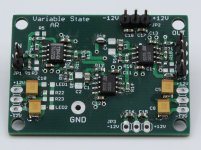 IMG_0564f.jpg404.1 KB · Views: 171
IMG_0564f.jpg404.1 KB · Views: 171 -
 Variable-State_RevA-sch.png215.9 KB · Views: 167
Variable-State_RevA-sch.png215.9 KB · Views: 167 -
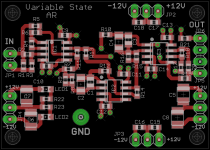 Variable-State_RevA-lay.png73.3 KB · Views: 155
Variable-State_RevA-lay.png73.3 KB · Views: 155 -
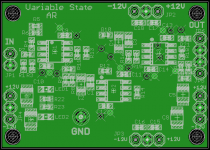 Variable-State_RevA-GND-lay.png19 KB · Views: 129
Variable-State_RevA-GND-lay.png19 KB · Views: 129 -
 Bild_6_Frequenzgang_alt.jpg168.3 KB · Views: 124
Bild_6_Frequenzgang_alt.jpg168.3 KB · Views: 124 -
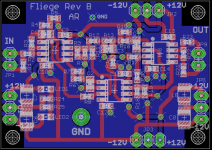 Fliege-SMD_RevA-lay.png28.1 KB · Views: 146
Fliege-SMD_RevA-lay.png28.1 KB · Views: 146 -
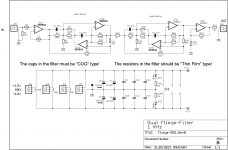 Fliege-SMD_RevA-sch-sw.png13.4 KB · Views: 148
Fliege-SMD_RevA-sch-sw.png13.4 KB · Views: 148 -
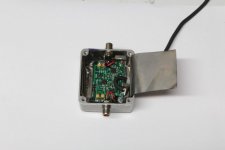 IMG_0557r.jpg41.6 KB · Views: 146
IMG_0557r.jpg41.6 KB · Views: 146 -
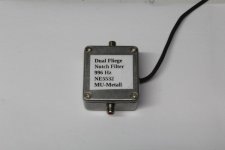 IMG_0555r.jpg43.4 KB · Views: 133
IMG_0555r.jpg43.4 KB · Views: 133 -
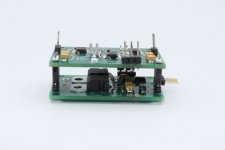 IMG_0548r.jpg35.5 KB · Views: 134
IMG_0548r.jpg35.5 KB · Views: 134 -
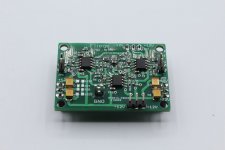 IMG_0545r.jpg68.7 KB · Views: 131
IMG_0545r.jpg68.7 KB · Views: 131 -
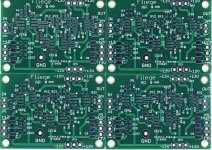 Dual-Fliege.jpg243.4 KB · Views: 138
Dual-Fliege.jpg243.4 KB · Views: 138
Jesper, you may get a better awareness of the HD levels by using coherent averaging, given the HD's are about the same level as the noise floor.
Jesper, you may get a better awareness of the HD levels by using coherent averaging, given the HD's are about the same level as the noise floor.
The number's stay's around same level, but it's "easier" to see the harmonics, as the noisefloor are reduced down.
Jesper.
I have PCBs for a dual Fliege Notch and a Variable State Filter (singel stage).
I added the schematics, the layout picture and some measurements.
... For different frequencies you need to use one PCB for each.
I did it for 1 kHz and 3.15 kHz for my usage.
This is the link to the calculators:
https://booksite.elsevier.com/9780123914958/content/Notch_Filter_Calculator/notch_2.htm
http://earmark.net/gesr/opamp/notch.htm
The Q should be 10.
Thanks a lot, Alfred, I had a quick look at all these with the updated homepage URL.
Looks great, by the way!
Hi all here at Magic's thread 🙂
I have been testing different amp's and dac etc.., since last time i wrote here.
This tool is absolutely nice to have, but there is some limitation's when it come's to testing low THD machines like DAC's.
I would say, that everything better than 90-95dB it's unclear if it's the Behringer or the DUT which dominates the THD's.
I made an passive notch last year, and this also helped me to better 'see' lower THD's. The creation along with compensation file and manuel fundamental settings for REW was somwhat a journey to understand, but everything is much more clear now, also regarding the difference between an active notch and a passive one.
So I wen't crazy and ordered the Cosmos APU https://e1dashz.wixsite.com/index/cosmos-apu
This guy know all about creating the calibration files, and he also tested Victor's with the notch, which I also did. (Thank's Arch!)
http://archimago.blogspot.com/2022/05/early-look-cosmos-apu-high-performance.html
I really 'needed' to see how (-)low i could push the Behringer
Mailman came around the other day with the nice package.

I took some day's to create the cables and the calibration files for REW, also to be sure that everything was correct.
I have testet some of my DAC's now, but the Victor's oscillator was something I really could use to see how good the APU notch is, or more like how good the combination with my Behringer is 🙂
https://viccc42.wixsite.com/uld-audio
I must say, that i'am glad i bought this active notch...
Here is the Victor's as a DUT.
Will post more finding within next day's...
Jesper.

I have been testing different amp's and dac etc.., since last time i wrote here.
This tool is absolutely nice to have, but there is some limitation's when it come's to testing low THD machines like DAC's.
I would say, that everything better than 90-95dB it's unclear if it's the Behringer or the DUT which dominates the THD's.
I made an passive notch last year, and this also helped me to better 'see' lower THD's. The creation along with compensation file and manuel fundamental settings for REW was somwhat a journey to understand, but everything is much more clear now, also regarding the difference between an active notch and a passive one.
So I wen't crazy and ordered the Cosmos APU https://e1dashz.wixsite.com/index/cosmos-apu
This guy know all about creating the calibration files, and he also tested Victor's with the notch, which I also did. (Thank's Arch!)
http://archimago.blogspot.com/2022/05/early-look-cosmos-apu-high-performance.html
I really 'needed' to see how (-)low i could push the Behringer
Mailman came around the other day with the nice package.
I took some day's to create the cables and the calibration files for REW, also to be sure that everything was correct.
I have testet some of my DAC's now, but the Victor's oscillator was something I really could use to see how good the APU notch is, or more like how good the combination with my Behringer is 🙂
https://viccc42.wixsite.com/uld-audio
I must say, that i'am glad i bought this active notch...
Here is the Victor's as a DUT.
Will post more finding within next day's...
Jesper.
I took some measurement's of my Topping E30II
It's getting close to the specs. from the manufactor 🙂
Jesper.
THD+N test:

Dynamic range test:

Data'sheet' :


It's getting close to the specs. from the manufactor 🙂
Jesper.
THD+N test:
Dynamic range test:
Data'sheet' :
Measuring DACs is not that straightforward. Happy to see this little soundcard manage it! BTW impressive DAC! Oversampling but a lot of digital filter options. My NOS/OS DAC -PCM 1794- for comparison. With ARTA I can't measure THD+N% as a absolute figure. I can only see how it visualizes on the graph...
Attachments
I wonder how you achieve these plots with the Behringer that is specified with 110dB S/N. Did you apply coherent averaging?
@bucks bunny
I'am not using coherent avg., but it's calculated number's duo to compensation file (mic. calibration file in REW)
The compensation file is created by measurement of the notch and alligned. See here
When using active notch it's more easy than dealing with passive one's (like I did a lot).
Ofcause the notch could add a little noise itself., but I can't really verify this.
Reason I got a bit better number's than Archimago is proberly? because I adjusted the notch to 998Hz (Same as Victors osc.) and -31dB deepth.
See also here
I also tried measuring it without the compensation file, then I just need to subtract -31(dB) from the result (this is also verified in the APU thread here at diyaudio)
Jesper.

I'am not using coherent avg., but it's calculated number's duo to compensation file (mic. calibration file in REW)
The compensation file is created by measurement of the notch and alligned. See here
When using active notch it's more easy than dealing with passive one's (like I did a lot).
Ofcause the notch could add a little noise itself., but I can't really verify this.
Reason I got a bit better number's than Archimago is proberly? because I adjusted the notch to 998Hz (Same as Victors osc.) and -31dB deepth.
See also here
I also tried measuring it without the compensation file, then I just need to subtract -31(dB) from the result (this is also verified in the APU thread here at diyaudio)
Jesper.
Well @MagicBusMeasuring DACs is not that straightforward. Happy to see this little soundcard manage it! BTW impressive DAC! Oversampling but a lot of digital filter options. My NOS/OS DAC -PCM 1794- for comparison. With ARTA I can't measure THD+N% as a absolute figure. I can only see how it visualizes on the graph...
We need to install a REW on your'e pc, maybee Linux as we discussed long ago... 🙂
Maybee a trip to Athens in 2023 ? 😀
Jesper.
It seems I'm cursed... I did move from 32-bit Win7 to 64-bit Linux but I had to install an older Kubuntu distro for reasons explained here: https://www.diyaudio.com/community/threads/does-linux-have-to-be-so-frustrating.387660/latest, which comes with pulse audio and it doesn't like REW.🙁 I also have a dedicated audio PC but it's not going to move from a striped Win7 installation, so it has to be another dedicated REW PC. Some day...
Hi @MagicBus
It's a bit hard, you having such a struggle to use linux with REW.
I did a bit of reading, but there is not much regarding this object.
I'am a long time linux user (like mid. 90' or so), and the learning curve is very steep as you proberly know.
This thread is proberly not the right one discussing this, but why is it you cannot use alsa instead of pulseaudio?
Did you simply try an
I really hope i can help somehow? - Let me know 🙂
Jesper.
It's a bit hard, you having such a struggle to use linux with REW.
I did a bit of reading, but there is not much regarding this object.
I'am a long time linux user (like mid. 90' or so), and the learning curve is very steep as you proberly know.
This thread is proberly not the right one discussing this, but why is it you cannot use alsa instead of pulseaudio?
Did you simply try an
Maybee?sudo apt install alsa-utils alsa-base
I really hope i can help somehow? - Let me know 🙂
Jesper.
Pulseaudio is a source of trouble when used for audio measurement. And if you purge it you may loose your entire desktop as well, like in LMDE distros. For that reason I have a distinct audio laptop with AV linux on it and pulseaudio purged. This actually works best for me. Otherwise it may help to customize pulseaudio (edit /etc/pulse/daemon.conf)
Trying to avoid purchasing another PC -which is not going to happen in the near future anyway... I spent the whole evening just to reinstall REW and alsa. It's me, I know... I haven't uninstall pulse and I'm not sure alsa remembers what it was told to do right after the terminal is closed, but I managed to see my soundcard in REW and not least make the volume controls to work. I can now adjust levels accurately and have a loop measurement with time reference. 👍 Calibration will follow tomorrow.
Instead of buying another PC you could boot from an external USB-stick/SSD-drive etc with a special audio system installed on it. I have a collection of outdated lenovo laptops, always bought 2.hand at prices around 200€.
Last edited:
- Home
- Design & Build
- Equipment & Tools
- Behringer UMC 202HD for measurements
